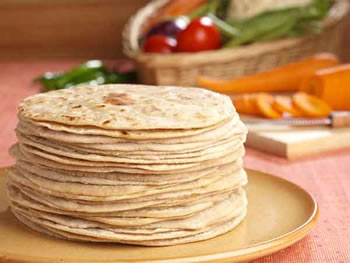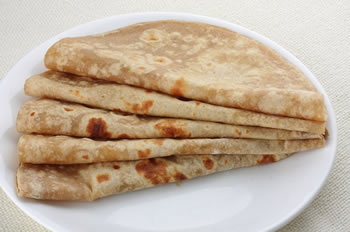Difference between Roti and Chapati
Key Difference: The terms Roti and Chapati are often regularly used when it comes to Indian cooking. In general terms, a roti is a type of Indian flatbread. There are many different types of rotis, one of which is the chapati, which is a type of roti that is made from whole wheat flour and cooked on the tava, a type of flat skillet.
 The terms Roti and Chapati are often regularly used when it comes to Indian cooking. In fact, they are pretty much a staple of Indian cooking and are often present at most, if not all Indian meals. However, different terms, such as roti, chapatti, phulka, etc. may be used. The usage of such varied terms leaves not only non-Indians, but Indians confused as well. The confusion behind the terms comes from the fact that there are so many different cultures and languages at play in India. Everybody has a different name for the same or similar thing.
The terms Roti and Chapati are often regularly used when it comes to Indian cooking. In fact, they are pretty much a staple of Indian cooking and are often present at most, if not all Indian meals. However, different terms, such as roti, chapatti, phulka, etc. may be used. The usage of such varied terms leaves not only non-Indians, but Indians confused as well. The confusion behind the terms comes from the fact that there are so many different cultures and languages at play in India. Everybody has a different name for the same or similar thing.
In general terms, a roti is a type of Indian flatbread that is made from whole wheat flour, which is locally known as atta. However, some people do tend to use all-purpose flour (maida) or a mixture of atta and maida. In most households, atta is used. A dough mixture is created from atta and water. Some people tend to add salt for taste, others don’t. Sometimes oil or milk is added to the mixture to change the texture and make the roti softer and chewier.
The dough is then divided into small palm shaped balls. These balls or portions are then rolled out either by hand or via a rolling pin into a thin flat circular shape. This is then cooked either on a tava, which is a type of flat skillet, directly on the flame, or in a tandoor, which is an open air coal oven.
 Each person has their own version of roti that they make at home. This version is based on personal preference, or more likely on the recipe that is passed down the generations in their family from mother to daughter. Hence, over time many different version have developed, and various different terms as well.
Each person has their own version of roti that they make at home. This version is based on personal preference, or more likely on the recipe that is passed down the generations in their family from mother to daughter. Hence, over time many different version have developed, and various different terms as well.
Most commonly, rotis are made from whole wheat flour and cooked on a tawa. This version of the roti is commonly called a chapati or chapatti. Hence, it can basically be said that a chapati is a specific type of roti. The chapati is the version of the roti that is eaten in most households. It is easily the most common type of roti consumed by the public. Yet many people still refer to this as roti, while others refer to it as chapati. It is mostly eaten with various types of dals, lentils, vegetables, etc.
Comparison between Roti and Chapati:
|
|
Roti |
Chapati |
|
Also known as |
Chapatti, Tandoori Roti, etc. |
Roti |
|
Type |
Type of Indian flatbread |
Type of Roti |
|
Ingredients |
Varied depending on the type of roti. Can be made from whole wheat flour, all-purpose flour, corn flour, etc. |
Typically made from whole wheat flour |
|
Thickness |
Varied, generally a bit thicker than chapati |
Generally a bit thinner than other most other types of rotis |
|
Cooking process |
Make dough from atta (whole wheat flour) and water Add salt and oil to taste Keep dough aside to proof Divide dough into small palm sized portions Roll each portion into a thin flat circular shape Cook roti on a hot tava (flat skillet) or a tandoor (open air oven) Remove from heat and eat or store |
Make dough from atta (whole wheat flour) and water Add salt and oil to taste Keep dough aside to proof Divide dough into small palm sized portions Roll each portion into a thin flat circular shape Cook roti on a hot tava (flat skillet) Remove from tava and eat or store |
Reference: Wikipedia (Roti and Chapati), Chef Raman, The CurryFocus Image Courtesy: boldsky.com, vegkitchen.com









Comments
Anku
Sun, 01/07/2018 - 17:44
KE Seet
Tue, 02/06/2018 - 13:53
Add new comment